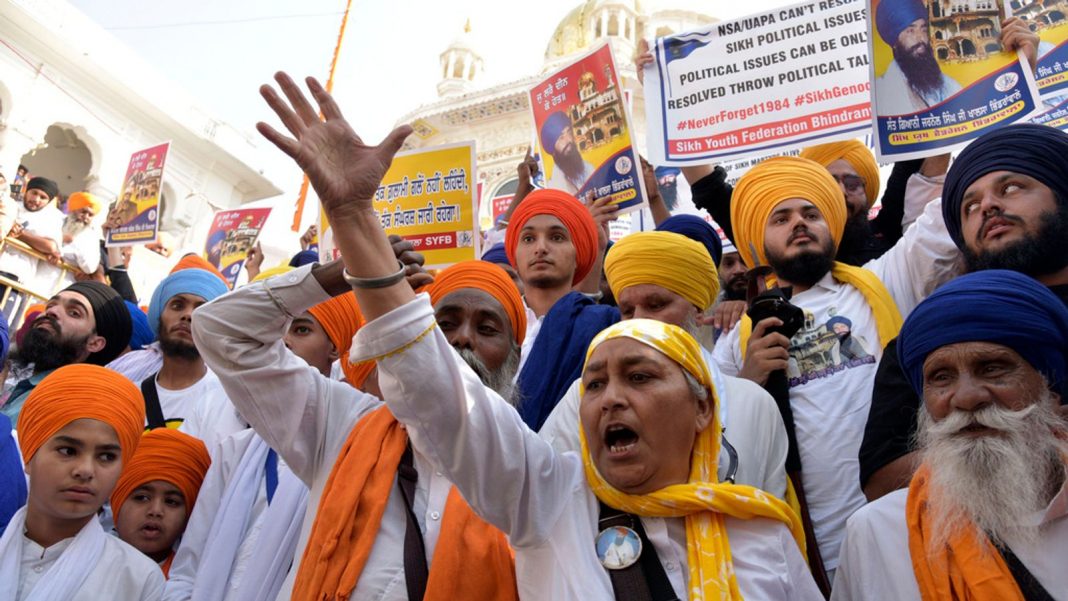Relations between India and Canada are at an all-time low after a Sikh leader was shot dead in British Columbia this summer.
India has expelled a Canadian diplomat after Prime Minister Justin Trudeau suggested Narendra Modi’s Indian government was behind the killing of Hardeep Singh Nijjar on 18 June.
Mr Nijjar was one of the key members of the Khalistan movement – and was in the process of organising an unofficial referendum on its proposed independent Sikh state when he died.
Sikh calls for their own country are mostly concentrated in the diaspora – but the origins of the movement date back to the end of the British Empire.
Here Sky News takes a look at the history of the Khalistani movement – and how it fits in with current tensions.
What is Khalistan?
Sikhs on the Indian sub-continent began calling for their own sovereign state amid the fall of the British Empire.
When India was partitioned along religious lines in 1947, the former Punjab province was divided between India and the newly created Pakistan.
This saw most Sikhs previously living on the Pakistani side move across the border.
Today, the population of the Indian state of Punjab is made up of 58% Sikhs and 39% Hindus.
Read more:
Is India about to change its name?
What we learned from India’s moon landing
Various groups helped form what became known as the Khalistan movement.
The Punjabi Suba movement called for the division of Punjab according to the different languages spoken there.
But the Akali movement, originally formed in the 1920s to ensure Sikh control of India’s Sikh places of worship (gurdwaras), reignited calls for a Sikh homeland.
Most who support it believe it would encompass most of the Indian Punjab – and some of the Pakistani side.
Some propose the Indian city of Shimla – or the Pakistani capital of Punjab, Lahore – as potential capitals for Khalistan.
The name comes from the Punjabi word Khalsa, which translates roughly as ‘to be pure’, ‘to be free from’ or ‘to be liberated’ but is also used generally for the community that considers Sikhism its faith.
Violence of 1980s and 90s
As momentum built for a separate Sikh state, some parts of the movement turned violent.
This armed insurgency was met by a severe government crackdown and thousands were killed.
In June 1984, Operation Blue Star saw Indian forces storm the Golden Temple, the holiest Sikh shrine in Amritsar – where separatists had taken refuge.

Sikhs carry rifles at the Golden Temple complex in May 1984. Pic: AP

Indian government troops stationed at the Golden Temple in June 1984. Pic: AP
Jarnail Singh Bhindranwale – a Sikh leader, violent revolutionary and key advocate for Khalistan – was among the hundreds killed. Sikh groups argue the true number of dead was in the thousands.
Months later on 31 October, Prime Minister Indira Gandhi, who had ordered the raid on the temple, was assassinated by two of her Sikh bodyguards in an act of revenge.
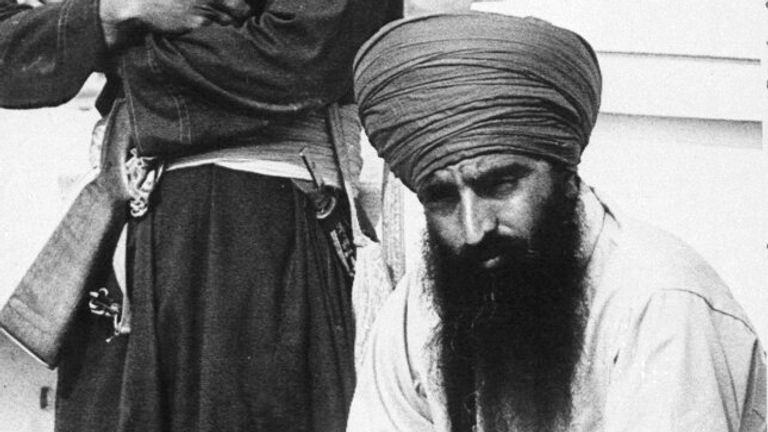
Jarnail Singh Bhindranwale at the Golden Temple in 1983. Pic: AP
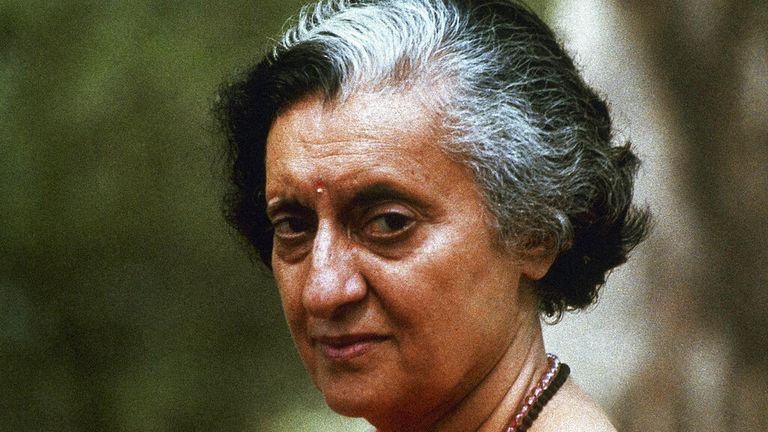
Indira Gandhi in 1980. Pic: AP
This led to a series of anti-Sikh riots across northern India, whereby Hindu mobs would go from house to house pulling Sikhs from their homes, before assaulting or killing them.
Various other violent incidents outside India were linked to the Khalistan movement – including the bombing of an Air India flight from Canada to Mumbai in 1985 that killed 329 people – and the attempted assassination of the Indian ambassador to Romania in Bucharest in 1991.
But as more lives were lost and the Punjabi economy took an increasing hit, the insurgency largely petered out by the mid-1990s.

Police disperse Sikh protesters in New Delhi in 1992. Pic: AP
What’s Canada got to do with it?
With the wave of immigration from India to the UK, Canada and Australia after India’s partition, the Khalistan movement has had consistent support among the Sikh diaspora.
In Canada, Sikhs make up roughly the same percentage of the population (2%) as they do in India (1.7%).
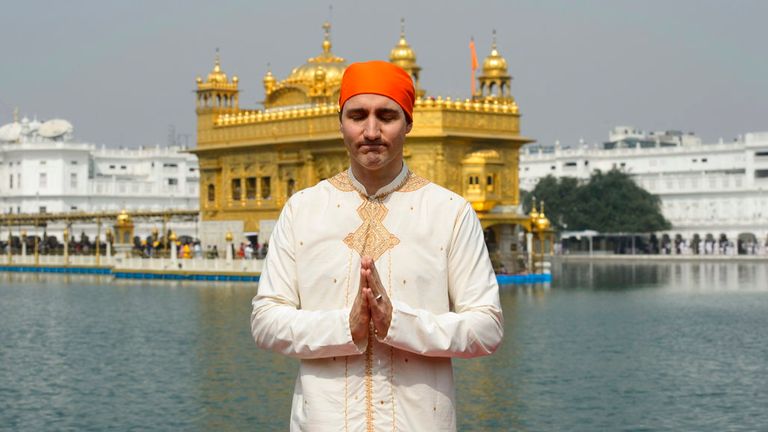
Canadian PM Justin Trudeau outside the Golden Temple in 2018. Pic: AP
They first arrived there in the early 20th century as members of the British Army, who stopped in British Columbia because of the fertile land.
The Indian government has become increasingly concerned by the prominence of the Khalistan movement abroad – calling on countries to take legal action against activists.
Aside from the shooting of Mr Nijjar, various other incidents have inflamed tensions recently.
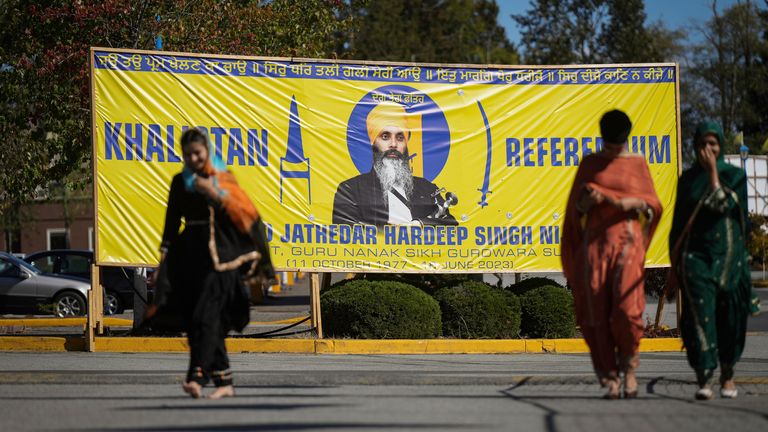
Hardeep Singh Nijjar on a banner in British Columbia. Pic: The Canadian Press/AP
Earlier this year the Indian flag at the High Commission in London was pulled down and a window smashed in protest against the arrest of radical Khalistani preacher Amritpal Singh.
Similar protests took place at the Indian consulate in San Francisco and the Indian High Commission in Ottawa.
Separately, when farmers demonstrated against a set of laws proposed by Mr Modi in 2020, he accused them of being Khalistanis.
In Canada, police are still looking for two “heavier-set” suspects they believe fled the scene of Mr Nijjar’s murder with a getaway driver.


